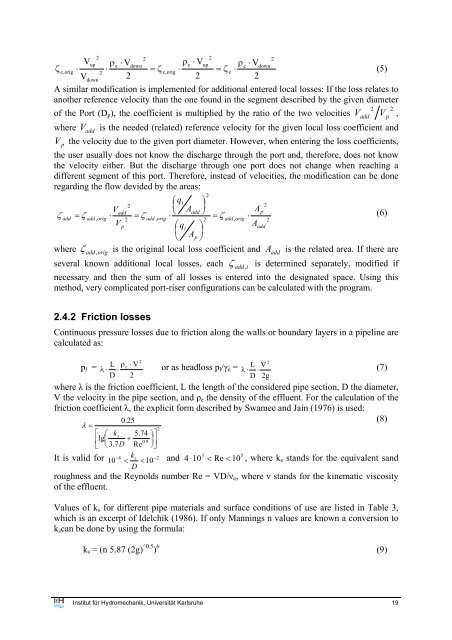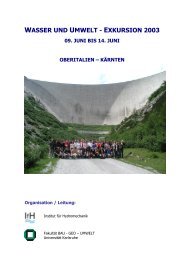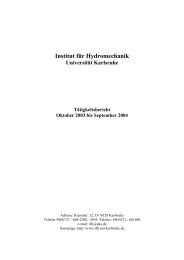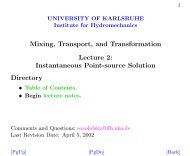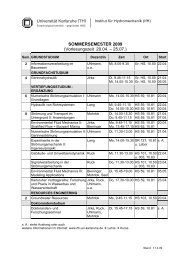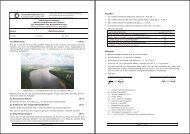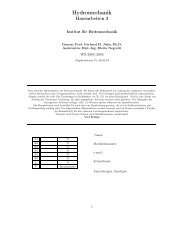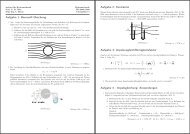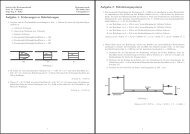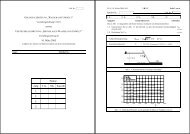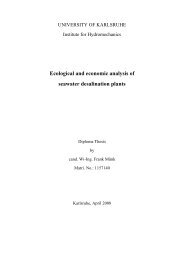user's manual for corhyd: an internal diffuser hydraulics model - IfH
user's manual for corhyd: an internal diffuser hydraulics model - IfH
user's manual for corhyd: an internal diffuser hydraulics model - IfH
You also want an ePaper? Increase the reach of your titles
YUMPU automatically turns print PDFs into web optimized ePapers that Google loves.
2<br />
2<br />
2<br />
2<br />
Vup<br />
ρ V<br />
V<br />
e<br />
⋅<br />
ρe<br />
⋅<br />
down<br />
up ρe<br />
⋅ Vdown<br />
ζ<br />
e,orig<br />
⋅ ⋅ = ζ<br />
2<br />
e,orig<br />
⋅ = ζ<br />
e<br />
⋅<br />
(5)<br />
V 2<br />
2<br />
2<br />
down<br />
A similar modification is implemented <strong>for</strong> additional entered local losses: If the loss relates to<br />
<strong>an</strong>other reference velocity th<strong>an</strong> the one found in the segment described by the given diameter<br />
2 2<br />
of the Port (D p ), the coefficient is multiplied by the ratio of the two velocities V ,<br />
where<br />
V p<br />
V add<br />
add<br />
V p<br />
is the needed (related) reference velocity <strong>for</strong> the given local loss coefficient <strong>an</strong>d<br />
the velocity due to the given port diameter. However, when entering the loss coefficients,<br />
the user usually does not know the discharge through the port <strong>an</strong>d, there<strong>for</strong>e, does not know<br />
the velocity either. But the discharge through one port does not ch<strong>an</strong>ge when reaching a<br />
different segment of this port. There<strong>for</strong>e, instead of velocities, the modification c<strong>an</strong> be done<br />
regarding the flow devided by the areas:<br />
2<br />
⎛qi<br />
⎞<br />
2<br />
2<br />
V<br />
⎜ A ⎟<br />
add<br />
A<br />
add<br />
p<br />
ζ add = ζ add , orig ⋅ = ζ<br />
2 add , orig ⋅<br />
⎝ ⎠<br />
= ζ<br />
2 add , orig ⋅<br />
(6)<br />
2<br />
V<br />
p<br />
⎛q<br />
A<br />
i<br />
⎞<br />
add<br />
⎜<br />
A<br />
⎟<br />
⎝ p ⎠<br />
where ζ is the original local loss coefficient <strong>an</strong>d is the related area. If there are<br />
add , orig<br />
several known additional local losses, each ζ<br />
add ,i<br />
is determined separately, modified if<br />
necessary <strong>an</strong>d then the sum of all losses is entered into the designated space. Using this<br />
method, very complicated port-riser configurations c<strong>an</strong> be calculated with the program.<br />
A add<br />
2.4.2 Friction losses<br />
Continuous pressure losses due to friction along the walls or boundary layers in a pipeline are<br />
calculated as:<br />
p l = L ρ ⋅ 2<br />
2<br />
e<br />
V<br />
λ ⋅ ⋅ or as headloss p l /γ e = L V<br />
λ ⋅ ⋅<br />
(7)<br />
D 2<br />
D 2g<br />
where λ is the friction coefficient, L the length of the considered pipe section, D the diameter,<br />
V the velocity in the pipe section, <strong>an</strong>d ρ e the density of the effluent. For the calculation of the<br />
friction coefficient λ, the explicit <strong>for</strong>m described by Swamee <strong>an</strong>d Jain (1976) is used:<br />
0.25<br />
(8)<br />
λ =<br />
2<br />
⎡ ⎛ k 5.74 ⎞⎤<br />
⎢lg⎜<br />
s<br />
+<br />
0.9<br />
⎟<br />
3.7 Re<br />
⎥<br />
⎣ ⎝ D ⎠⎦<br />
It is valid <strong>for</strong> −6<br />
k −2<br />
10 < s<br />
3<br />
5<br />
< 10 <strong>an</strong>d 4 ⋅10<br />
< Re < 10 , where ks st<strong>an</strong>ds <strong>for</strong> the equivalent s<strong>an</strong>d<br />
D<br />
roughness <strong>an</strong>d the Reynolds number Re = VD/ν e , where ν st<strong>an</strong>ds <strong>for</strong> the kinematic viscosity<br />
of the effluent.<br />
Values of k s <strong>for</strong> different pipe materials <strong>an</strong>d surface conditions of use are listed in Table 3,<br />
which is <strong>an</strong> excerpt of Idelchik (1986). If only M<strong>an</strong>nings n values are known a conversion to<br />
k s c<strong>an</strong> be done by using the <strong>for</strong>mula:<br />
k s = (n 5.87 (2g)^0.5 ) 6 (9)<br />
Institut für Hydromech<strong>an</strong>ik, Universität Karlsruhe 19


